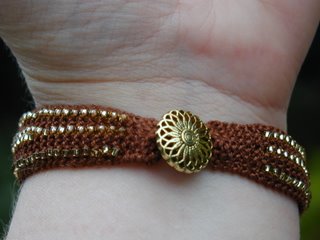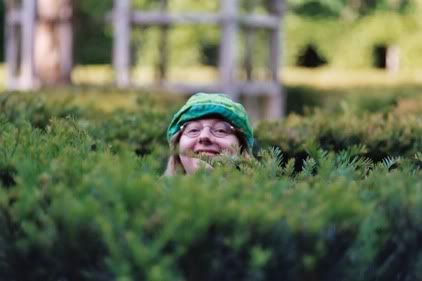Knitting with beads
At the April meeting of our knitting group the theme was knitting with beads. We had a go at four different methods of incorporating beads into our knitting, these were all methods which required you to thread your beads onto your yarn first.

Here is the sample I produced, the yarn is Size 8 perle cotton, and the beads are No. 11, or at least I think that is what they are. These were some pre-strung beads I had left over from knitted beaded baubles I made a few years ago so I am not entirely sure what they are as I haven't got the ball band for the yarn or the bag for the beads any more.
The first two zigzags on the sample show slip stitch beading. This is when, on a knit row you stop just before the stitch you want your bead to be in front of, then you bring your yarn forward, slip the stitch purlwise, then push a bead up the yarn so that is sits in front of the slipped stitch, and then bring the yarn back and continue knitting as usual. You can do the same thing on a purl row but then you will bring the yarn to the back to place the stitch, and forward again to continue purling.
The difference between the two zigzags is that for the first one the beads were all added on the knit rows and on the second one the beads are all added on the purl rows. I think you could probably do a mixture of the two which would be quite interesting but you do have to be careful about getting the beads too close together or they wont lie flat.
The U shaped sample is adding the beads between the stitches on garter stitch. There are no slip stitches here, and the beads appear on the side away from you when you are adding them. To place a bead between two stitches you simply knit to the appropriate point, slip a bead up the thread so that it sits right next to the stitch you have just knitted, then you knit the next stitch, anchoring the bead in place. This is the same method used for the knitted baubles and also for the Victorian bead purses I have seen. If you add beads on all rows you get a reversible fabric. For this sample however I decided to only bead on one side so every alternate row is just plain knit. You can create interesting shaping by having more beads between each stitch.
Finally the rather pathetic line of beads at the top of the sample is my attempt at close beading, this is bead knitting rather than beaded knitting (which the other methods are types of) and the bead actually sits on the stitch rather than in front of it in the slipped stitch method, or between stitches in the garter stitch method. I found it incredibly hard to get the bead to go through the stitch, probably because I knit quite tightly, close beading I feel is not for me.
After the workshop I was inspired to have a go at a bracelet, partially inspired also by one that Janine had made although I wanted something a bit narrower, and I wanted to experiment with increasing the number of beads between stitches more gradually. Here are the results:
 It is surprisingly difficult to photograph your own wrist! I think I probably should have waited for Paul to come home so that I could borrow him and his superior photographic skills :-)
It is surprisingly difficult to photograph your own wrist! I think I probably should have waited for Paul to come home so that I could borrow him and his superior photographic skills :-)

Here is the fastening, using a rather nice button I found in John Lewis. Although I failed to take a picture of the other side it is actually reversible. This is using the garter stitch beading between the stitches method, and increasing and then decreasing the number of beads between the stitches. This gives a shaped bracelet even though every row has the same number of knit stitches in it. If anyone is interested in the pattern let me know and I'll write it up and put it on the blog.
Although I failed to take a picture of the other side it is actually reversible. This is using the garter stitch beading between the stitches method, and increasing and then decreasing the number of beads between the stitches. This gives a shaped bracelet even though every row has the same number of knit stitches in it. If anyone is interested in the pattern let me know and I'll write it up and put it on the blog.


1 Comments:
At 8:04 pm, Daisy said…
Daisy said…
Thanks for the explanation of the different ways of beading! It's really helped me to get my head round it. (I'm going on a course in October!)
Post a Comment
<< Home